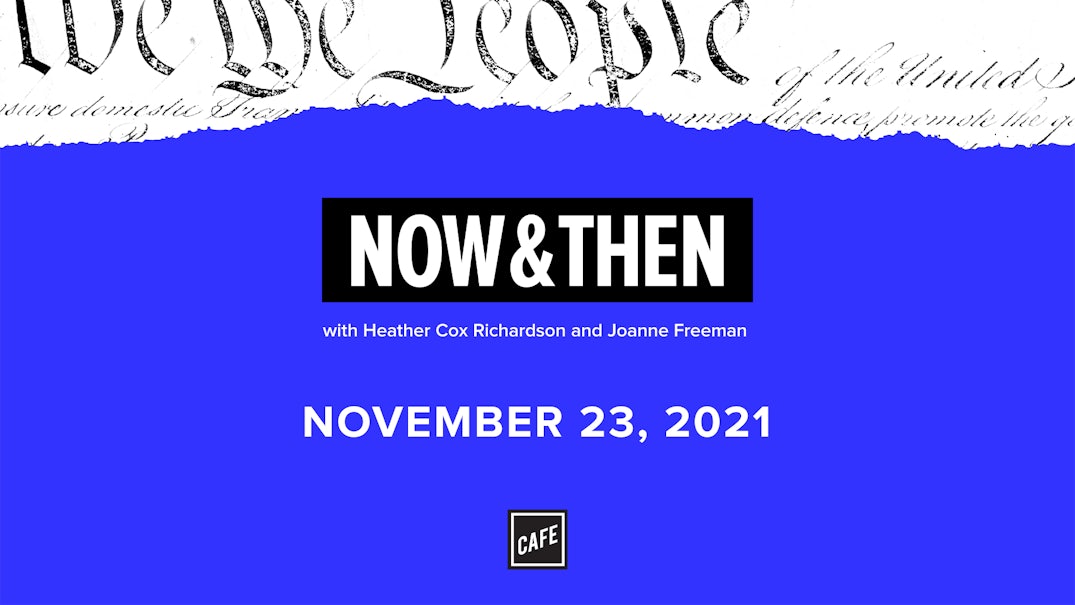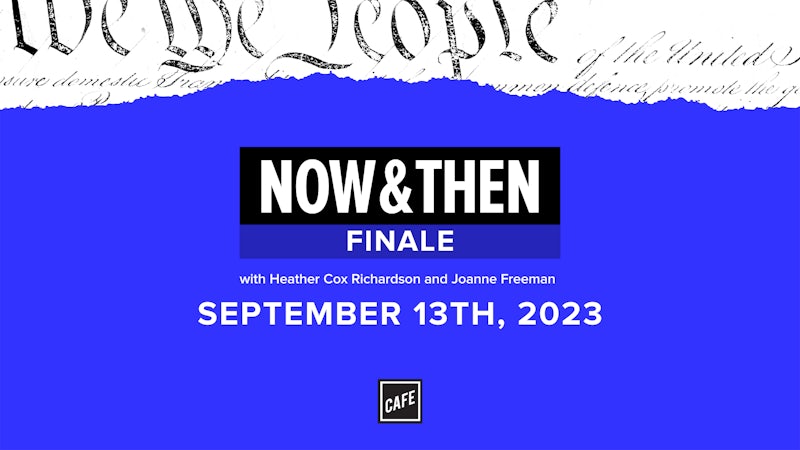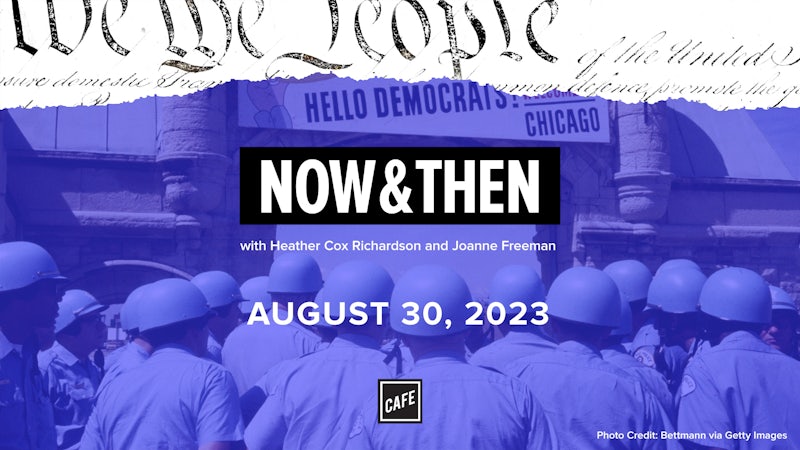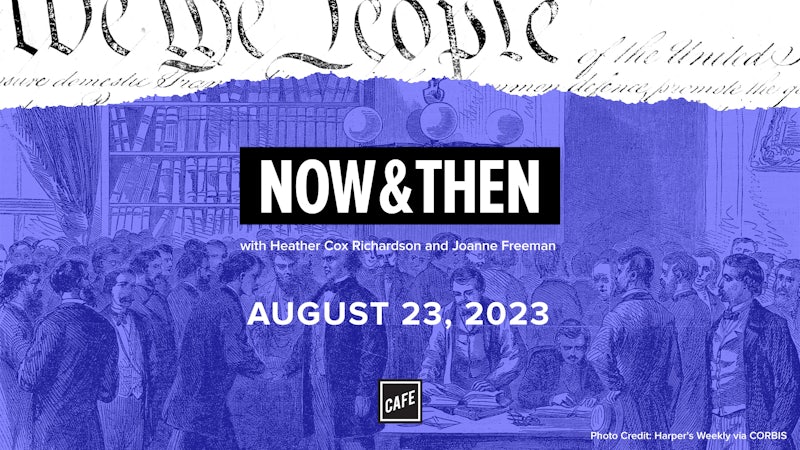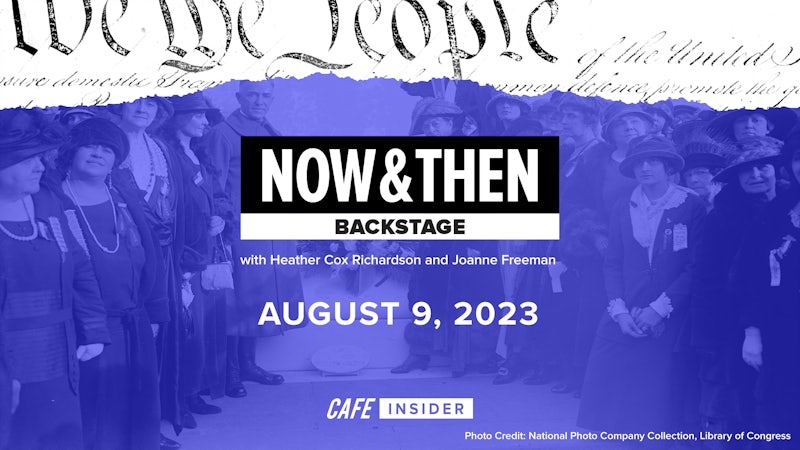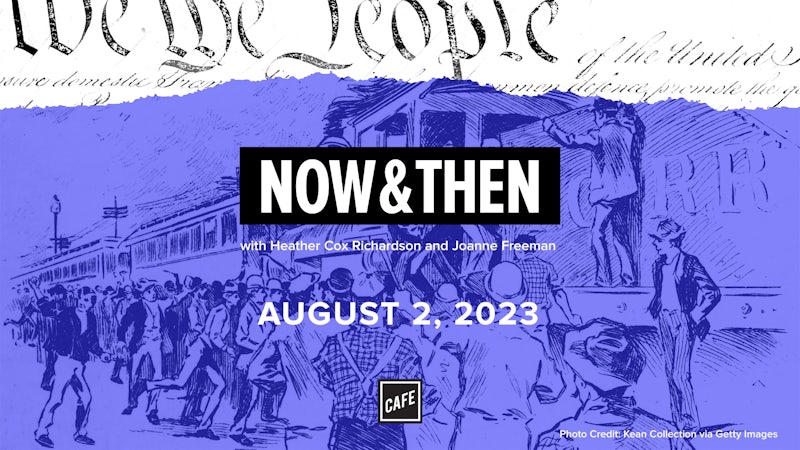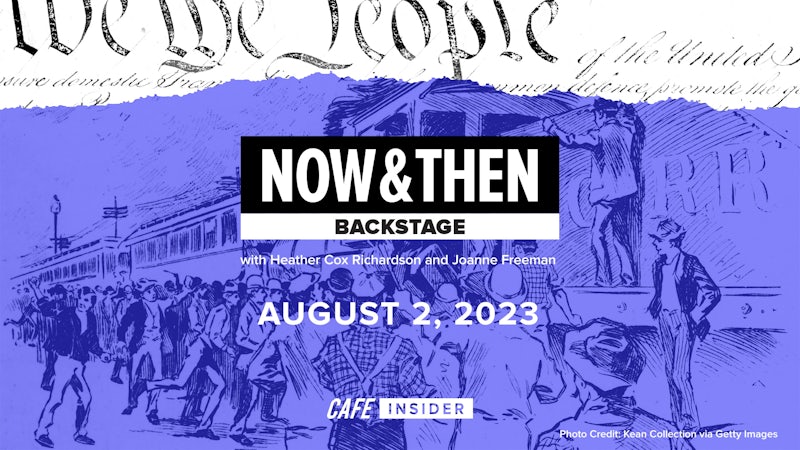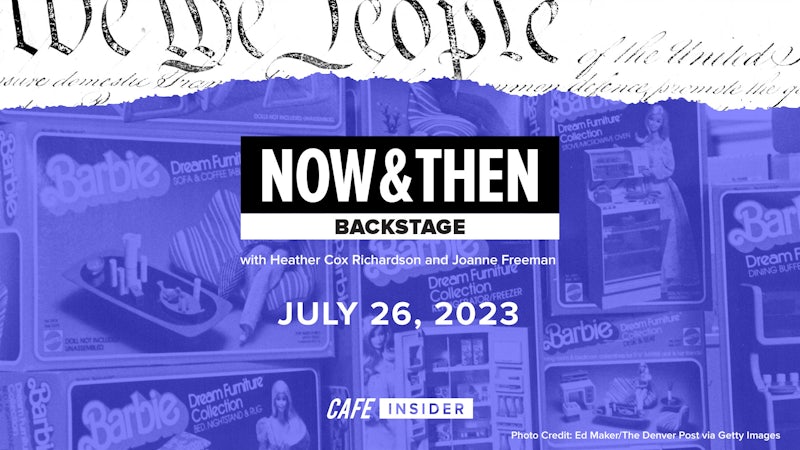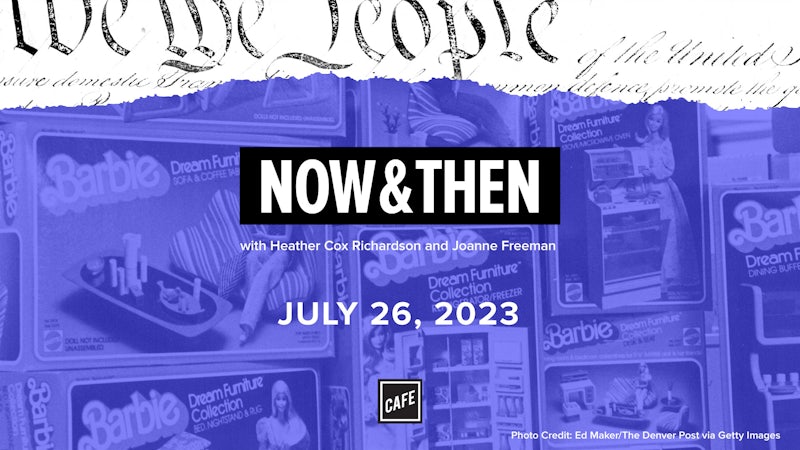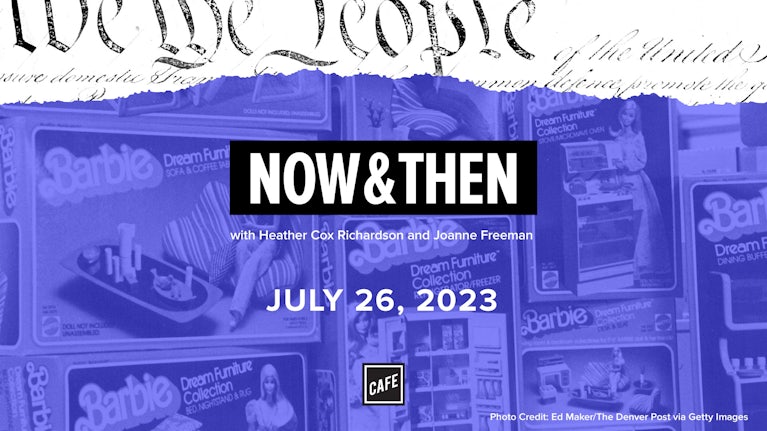Heather Cox Richardson:
From Cafe and the Vox Media Podcast Network, this is Now and Then. I’m Heather Cox Richardson.
Joanne Freeman:
And I’m Joanne Freeman. Today we’re going to be talking about something that will not be at all surprising. And that of course is Thanksgiving Day. The more that we chatted, Heather and I, about this episode, the more it became clear that rather than just the holiday itself, one of the things that was really interesting was the way in which, at different periods of time, people focus on the holiday in a way that epitomizes that moment in time. So in other words, this national holiday of Thanksgiving ends up being kind of a mirror of the nation at a given time.
And that’s what we want to explore today. We want to work our way through American history, looking at the trail of how Thanksgiving was seen, how Thanksgiving was used and what it meant to different people at different times and what that suggests about the trail of American history overall. Now the first thing I’ll say right off the cuff, and then we can back away from it is of course, what are we talking about this year? We’re talking about vaccines. Everyone’s talking about Thanksgiving and families going to be together. And what do you do about unvaccinated family members? Last year’s variant of that was social distancing. Should we get together at all? How should we socially distance? So we are following the pattern that you and I, Heather, are going to be talking about just in the last two years.
Heather Cox Richardson:
Well, and I told you I would behave today. And you knew I didn’t mean it.
Joanne Freeman:
Of course you didn’t mean it.
Heather Cox Richardson:
Because one of the words that you used when you first came up with this idea was the idea of Thanksgiving as being subversive. That is, in many ways, when we think about a national Thanksgiving, there is sort of this umbrella of this is what the nation means. And yet within that, there have always been alternative voices that are saying, no, that’s not what this nation means. In fact for-
Joanne Freeman:
Well, they asked for that.
Heather Cox Richardson:
That’s right.
Joanne Freeman:
They ask for that. If you say, this is what the nation means, what you’re saying is please, people who don’t agree with it, speak up now.
Heather Cox Richardson:
Yes. And that’s exactly what we found throughout American history. When we looked at the concept of Thanksgiving and of what Thanksgiving would mean, there were always voices saying, now hang on just a minute. And in many ways, that makes sense of the weird cultural moments that surround Thanksgiving where in many ways, Thanksgiving is this incredibly family-oriented national moment that is not religious, but that we’re all supposed to be coming together and giving thanks. And in many ways it’s very anodyne.
And then you sort of have, coming in from the side, people going no, wait a minute here. I’m going to go ahead and sing protest songs, or I’m going to go ahead and tweet all the ridiculous things that people do in my community on Thanksgiving. Or we have this vision, and you hear this all the time, of the uncle in the attic, the guy who we’re supposed to ignore at Thanksgiving. So there’s never really anybody who comes out and says, “My Thanksgiving was perfect.”
Joanne Freeman:
No. Well, if they do there, you would really be suspicious of that human being because Thanksgiving, in a sense, well, in a sense, based on what you’re saying and what I’ve just said, is about dissent.
Heather Cox Richardson:
So let’s start there. This is a beautiful place for you to start with the very surprising origins of American Thanksgiving. And they are not in 1621.
Joanne Freeman:
They are not because of course America or the United States is not around at that point. And I should note at this point that there are days of Thanksgiving when the nation gives thanks for things. And in this case, that’s what I’m going to be talking about was the idea that the president should declare a day of Thanksgiving.
This takes place in 1789, which is the first year that the government is in operation. And Washington wants to declare a day of Thanksgiving to honor the new Constitution. And so there is a debate among members of Congress as to what people think about this. One person says this feels awfully national to me. Shouldn’t this be an issue that just goes to the states? I mean, this is a matter of state power. Representative Aedanus Burke of South Carolina says, “This seems awfully European to me. This doesn’t seem as though it’s truly American, this whole idea of a Thanksgiving Day.” Connecticut’s Roger Sherman says, “It’s warranted by the Bible.”
So this first moment, when all they’re saying is let’s have a day of Thanksgiving, a formal day of Thanksgiving, a proclamation, immediately, what you get is dissent. People talking along the lines of where their sympathies are. It’s about federalism and state power. No, no. It’s about American things versus European things. No, no. It’s about religion from that first moment that it’s even mentioned. So you can get a flavor of what the show’s going to be like I think even from this beginning episode.
Heather Cox Richardson:
I’m laughing at you using the word flavor because honestly it sounds like people fighting over the gravy. Like, no, that’s not how we’re making the gravy this time. And those of you in the other room are like, we just want the gravy.
Joanne Freeman:
That’s right. Now, I will say to conclude this story that we do actually end up with Washington, as he puts it, recommending and assigning Thursday the 26th day of November, “to be devoted by the people of these states to the service of that great and glorious being who is the beneficent author of all the good that was, that is, or that will be that we may, that all unite in rendering unto him our sincere and humble thanks.” Blah, blah, blah, blah, blah, for the war in…
Heather Cox Richardson:
Oh, come on. You can’t do that. If you’re going to do it, you got to read it.
Joanne Freeman:
It’s really long. I can. I know him really well. But I’ll take back the blah, blah blahs. Okay. So we are, “giving humble thanks for the signal and manifold mercies and the favorable interpositions of his providence in the course and conclusion of the late war for the great degree of tranquility union and plenty, which we have since enjoyed for the peaceful and rational manner in which we have been enabled to establish constitutions of government for our safety and happiness and particularly the national one now lately instituted.”
Heather Cox Richardson:
So this is great. Now we have a national Thanksgiving and Adams is going to do it. And then we’ve got one forever. Oh, wait. What about Jefferson?
Joanne Freeman:
I was going to say, I just was reading over our notes and I thought, oh gosh, here comes Jefferson. Here comes Thomas Jefferson. But I want to hear you talk about this rather than have me, because he’s doing something that one might argue is actually a fine thing to do. So how do you interpret this?
Heather Cox Richardson:
You did this on purpose, didn’t you? Because I have to actually say that Jefferson recognizes that the language that people are using to go ahead and argue for a national day of Thanksgiving is astonishingly religious for a country that is supposed to have a separation of church and state. And so he actually says he will not be offering Thanksgiving proclamations after 1802 because he doesn’t want the president of the United States calling for what is in those days, an explicitly religious holiday.
Joanne Freeman:
I was going to say in true Jeffersonian manner, he says, “I know it will give great offense to the New England clergy, but the advocate for religious freedom is to expect neither peace nor forgiveness from them.” So that’s his equivalent of blah, blah, blah.
Heather Cox Richardson:
So we have this concept of the origins of a national Thanksgiving that has connections to religion that make Jefferson stop doing it. Madison’s going to go ahead and call for a couple of Thanksgivings during the war of 1812. But you’re going to get another presidential Thanksgiving proclamation for a very long time. And I want to hold off on when that is because I think the lead up to how we get that is really interesting.
Joanne Freeman:
Well, this goes right back to our theme about Thanksgiving really reflecting what’s happening in the nation at the time is that before the moment that we’re leading up to and where we actually get a national Thanksgiving from, we do have the recognition by people all over the United States that Thanksgiving appears to be mostly a Northern holiday. And when I looked around in Southern newspapers, as one does in preparing for this conversation, over and over and over again, they will say in one way or another the Northern and they always have in quotation marks Thanksgiving Day. And it’s decidedly Northern and over time, it also becomes something that begins to be criticized as Northern and thus bad for all of the reasons that the North are bad. So it becomes a sign in a sense of sectionalism or a declaration of sectionalism.
Now one person who steps forward in this definitely pre-war period is Sarah Josepha Hale, a school teacher, a writer. She is editor of Godet’s Lady Book. She’s someone who’s quite accomplished and has her finger in a lot of different dishes. She actually also wrote Mary Had a Little Lamb. So you know something now that you can use at your Thanksgiving table for odd reasons, if you’re looking for trivia.
Heather Cox Richardson:
And she has five kids and her husband dies. So she’s got to find a way to support them. And she’s well educated.
Joanne Freeman:
She’s very well educated.
Heather Cox Richardson:
Aside from the Mary Had a Little Lamb thing.
Joanne Freeman:
Well, yeah. But we still know it. It sold. So she begins to write editorials and articles at Godey’s Lady’s Book about the need for a national Thanksgiving, actually the need even for states to make formal declarations of Thanksgiving, to make regular holidays. And she begins to write to governors in various states, urging them to make a national day of thanks on the last Thursday of November. And she explicitly says, “At a time when sectional tensions are rising, this idea of a national day of Thanksgiving is going to ease the tensions and bring the North and South together.” And indeed by 1854, not only because of her, but she certainly helps, more than 30 states and U.S. territories have some kind of a Thanksgiving celebration on the books.
Heather Cox Richardson:
And you might have noticed that we didn’t talk about the pilgrims in the formation of the national Thanksgiving holiday. And that’s because when Sarah Josepha Hale starts talking about them, she’s talking about the kind of foods and things that she’s publishing in Godey’s Lady’s Book. But it’s really after 1841 when a man, again from Boston, a guy named Reverend Alexander Young publishes a book called the Chronicles of the Pilgrim Fathers of the Colony of Plymouth that popularizes the idea of the 1621 feast between the indigenous people in Massachusetts and the pilgrims who were celebrating the fact they had managed to survive as a colony. Many, many, many of them had died after their settlement of Massachusetts in 1620. They come together in the fall of 1621 to go ahead and actually have a feast. And that shows up in this book. But at that feast, and we have two accounts of the feast, one from William Bradford, who was the leader of the pilgrims, and one partly written by him, partly written by Edward Winslow, talking about what life was like in the early colony in a book called Mourt’s Relation.
And in that, when they talk about the feast, they talk about how it comes to happen. And in Mourt’s Relation says in a letter, “Our harvest being gotten in, our governor sent four men on fouling so that we might after have a special manner rejoiced together after we had gathered the fruit of our labors. They, four in one day, killed as much foul as with a little help besides, served the company almost a week. At which time, amongst other recreations, we exercised our arms. Many of the Indians coming amongst us and among the rest, their greatest king Massasoit with some 90 men, whom for three days, we entertained and feasted. And they went out and killed five deer, which they brought to the plantation and bestowed on our governor and upon the captain and others. And though it be not always so plentiful as it was at this time with us, yet by the goodness of God, we are so far from want that we often wish you partakers of our plenty.”
And this is a letter reproduced in this book called Mourt’s Relation, published in the 1622, that related that feast which did happen at the initial encounter moment between the devastated indigenous population from disease that the Europeans had brought even before the pilgrims came. The diseases came on fishermen and explorers. The meeting between those indigenous people and the English pilgrims who are settling and then who end up being devastated by the winter of 1620 when so many of them die. And they have this moment in 1621 when they are both sort of trying to figure out how to create some kind of an alliance that’s going to help them to survive. Now, that really is not part of the Thanksgiving literature until after 1841 and this reclaiming of that story for this Thanksgiving theme that Sarah Josepha Hale is pushing as hard as she is.
Joanne Freeman:
Which is interesting because I think we assume, or certainly a lot of Americans assume, that’s when you think of Thanksgiving, that’s what you think of is that story period. And as with everything else we’re talking about in this episode, Heather, it comes along at a certain moment for certain reasons. It’s not inborn into the holiday the way that Americans think about it.
Heather Cox Richardson:
So Sarah Josepha Hale is trying to push this idea of union between the sections by reaching back to a shared past. And one of the things that always jumps out to me when I study American history is at the moments when Americans reach back, way back in their past, they’re almost always trying to get away from the conflicts of the present. And this is no exception to that at all. But the South is not what one would call persuaded.
Joanne Freeman:
The South is not persuaded. And I think along those lines, along with what you just said, people reaching back in time or trying to get away from the present, they’re also trying to grab at legitimacy in authority in one way for another, too. That’s also part of it. But in this case, the South isn’t thinking along those lines. The South in the 1850s, beginning of the Civil War, they see Thanksgiving, or as they put it, the Northerner’s “Thanksgiving Day”, which is how they tended to refer to it in Southern newspapers. I did a lot of newspaper digging this morning. That’s a Northern thing. And it says a lot about the North. And of course that means it says a lot of bad things.
So this is from a Richmond newspaper, not long after the outbreak of the Civil War. I’m going to give you a little taste of it. “In the celebration of Christmas, the Southern people possess one of those strongly marked customs which link them together as when people and draw the line of demarcation very distinctly between them and their late associates. The people of the Northern states of the late Union, whether from the importation of foreign customs or from the old puritanism which rendered them averse to every exhibition of human happiness, give but an inferior rank to Christmas. In some of those states, New Year’s Day as in France, is the gala day of the year. In others, where political enthusiasm transcends religion, exaltation, the 4th of July is the favorite anniversary. While the original Yankee, Plymouth Rock Yankee, reserves his devotion and his dinners, his hymns of praise and his family reunion to the ‘Thanksgiving Day’ appointed by himself, free from every stain of super just tradition or ecclesiastical pomp.”
And then at the end, it concludes by saying, “Let Yankeedom rejoice in its self-righteousness.” So definitely not buying onto the whole Union idea.
Heather Cox Richardson:
So there’s another great exchange between Sarah Hale and Henry Wise that’s really interesting too, in the sense that what Sarah Hale is doing is she is really using the idea of a woman’s sphere in the 1850s to go ahead and stop the crisis that’s being created in the man’s sphere of politics. So in many ways she reflects somebody like Harriet Beecher Stowe, who writes Uncle Tom’s Cabin, essentially to women to say we got to make sure that we women and children stick together while the men go off and do things like pass the Fugitive Slave Act of 1850. And Sarah Joseph Hale is sort of like if we can just get people around the table and we can maybe get away from all this nasty politics.
So she writes a letter to Henry Wise. And Henry Wise is going to be the governor of Virginia. And he’s got his fingers in any number of secessionist pies. And she writes this letter where she says, “Well, I’m aware that Virginia has not often joined in keeping this festival, but this year, when, as I trust the Democratic party will gain such a victory as will ensure the perpetuity of our beloved Union. Surely the old dominion will gladly keep the day of Thanksgiving and lead in the festival of states.” And your friend Henry Wise, Joanne, responds, “Sure, Sarah. That sounds great.”
Joanne Freeman:
Well, and I will say he’s only my friend because he’s the most frequent fighter in the U.S. Congress in his career in Congress, before he becomes governor of Virginia. So I suppose he’s a friend to me in providing me with historical fodder. But Governor Wise, who is the man ultimately who signs John Brown’s death warrant says to Sarah Hale, “This theatrical national clap trap of Thanksgiving has aided other causes in setting thousands of pulpits to preaching Christian politics instead of humbly letting the carnal kingdom alone and preaching singly Christ crucified.” So those other causes left there unnamed is part of what he’s objecting to.
Heather Cox Richardson:
So this leads us into the Civil War. And there are a number of American states and territories that are celebrating some kind of state Thanksgiving, but we don’t have a national Thanksgiving. And in 1862, a number of the governors of the United States of America, the different states, recognize that in some fashion they have to go ahead and acknowledge the extraordinary suffering of their people, and yet keep them on the Union bandwagon. Go ahead and keep them loyal to the cause of the Union.
Joanne Freeman:
And boost morale, right?
Heather Cox Richardson:
And boost morale. So in the November and December of 1862, 17 state governors declared state Thanksgiving holidays. And New York governor Edwin Morgan led the way with a proclamation that was widely reprinted across the Union reflecting that the previous year, as he said, “is numbered among the dark periods of history. And it’s sorrowful records are graven on many hearthstones. But,” he said, “Nonetheless, this was time for giving thanks because,” as he wrote, “the precious blood shed in the cause of our country will hallow and strengthen our love and our reverence for it and its institutions. Our government and institutions placed in jeopardy have brought us to a more just appreciation of their value.”
So the next year Lincoln gets ahead of the state proclamations. And in July of 1863, he goes ahead and declares a national day of Thanksgiving. And he is reacting to the fact that the tide has finally turned and the Union armies are starting to win. So in July of ’63 at Gettysburg, the Union troops have sent the Confederates reeling back toward the South. Also in July of that year, Vicksburg had fallen a General U. S. Grant. It’s clear that the Union is now making up the ground that it lost in ’61 and ’62. So Lincoln goes ahead and he sets Thursday, August 6th, 1863 as the nation’s day of Thanksgiving.
And on that day, ministers across the country literally stand in the pulpit and they read off the victories of the U.S. Army and the U.S. Navy in the past year. And they promise their congregations that it’s only a matter of time until the Union goes ahead and wins against the Southern rebellion. They go ahead and they do recognize the sacrifices that people have made, but they say those sacrifices have not been in vain.
And then in October of 1863, Lincoln goes one better. He declares a second national day of Thanksgiving. And he argues that in the past year, the nation had truly been blessed. The country had been, as he said, “filled with the blessings of fruitful fields and healthful skies and in the midst of a civil war of unequaled magnitude and severity, which has sometimes seemed to invite and provoke the aggressions of foreign states. Peace has been preserved with all nations, order has been maintained, the laws have been respected and obeyed and harmony has prevailed everywhere except in the theater of military conflict. But that theater has been greatly contracted by the advancing armies and navies of the Union.”
And then here’s the kicker in this. He says, “While everybody had been terribly concerned about this war taking all the strength away from the United States, in fact, that didn’t happen. That the diversions of wealth and strength from the fields of peaceful industry to the national defense have not arrested the plow, the shuttle or the ship.” And he goes on to talk about population increasing, the country is getting stronger. It’s spreading out. And everybody can expect that this is going continue going forward. He says, “We’ve managed to pay for the war as we went. Our farming is strong. Our industry is strong. Our mining is strong. Our shipping is strong. We’ve got immigrants coming in to replace the men we’ve lost on the battlefield. The economy is booming. And the country,” he said, “with a large increase of freedom, would survive stronger and more prosperous than ever.”
And so he goes ahead and he invites Americans in every part of the United States and also those who are at sea and those who are sojourning in foreign lands to observe the last Thursday of November as a day of Thanksgiving. Now there’s a kicker in that. The last day of November, the last Thursday of November in 1863, is on November 26th. What does he do less than a week before that? On November 19th, he gives the Gettysburg Address. So he has set up with that Thanksgiving proclamation in October, and he actually uses a lot of the same phrases, the Gettysburg Address.
Joanne Freeman:
So we have this wonderful image, Heather, that you’ve presented of Lincoln promoting harmony and giving thanks and bringing the nation together and rejoicing over what everything that the nation does have at that crucial moment. A year later, we have Tecumseh Sherman, General Tecumseh Sherman making his march through Georgia. And at that moment, the New York Times, here’s their take on Thanksgiving. It rejoices that Sherman is sweeping through Georgia. It talks about the fact that, and as it puts it, it is not impossible that as Sherman’s soldiers marched along, “they took occasion to pick up and bear aloft, on their bayonets, all the turkeys, geese, and chickens of Georgia to furnish themselves with a Thanksgiving feast today.”
So one year after the Lincoln speech trying to pull people together, here’s Sherman devastating Georgia, and the New York Times presenting this image of Union troops with turkeys taken from Georgia on their bayonets so that they can celebrate Thanksgiving. So harmony didn’t last too long necessarily after that proclamation.
Heather Cox Richardson:
Well, in speaking of your idea about subversion, quite literally, here you’ve got Lincoln with his grandiose language about unity and we’re creating this great country. And here’s the New York Times, which is a Republican paper, being like, yeah, we’re going to get the Southerners. Look at what Sherman’s doing. And yes, that’s exactly what Sherman’s troops were doing is the whole point was to go ahead and create a swath across Georgia that was devastated. I suspect they weren’t just eating turkeys and geese and chickens, but also…
Joanne Freeman:
That’s actually a rosy picture is what that is. So then post that, after that point, we’re talking now about 1864, go ahead a little bit in time. And by 1870, President Ulysses S. Grant signs into law The Holidays Act that makes Thanksgiving a yearly appointed federal holiday in Washington D.C. And then 15 years later, January 6th, 1885, an act by Congress makes Thanksgiving and other federal holidays paid holidays for federal workers throughout the United States. So we’re moving ahead with Thanksgiving getting cemented as a holiday.
Heather Cox Richardson:
And in the immediately after that in the 1890s where the country is so driven by strikes and by economic conflict and by continuing sectionalism and racial conflict across the country, there is, once again, this drive to reach back to the sort of recipes that Sarah Josepha Hale had talked about and this old colonial history of this theoretically peaceful moment in which indigenous Americans and pilgrims managed to come together. And in 1895, the Reverend William DeLoss Love writes a book called The Fast and Thanksgiving Days of New England in which he says, “As we look back upon the first Thanksgiving,” and he’s inventing this, of course. “After nearly three centuries, it seems so wonderfully like the day we love that we claim it as the progenitor of our harvest feast.” So he’s very deliberately now reaching back to that 1621 image that is really being created as a moment that says, look how everybody can really live in peace as they circle around Sarah Josepha Hale’s squash and turkey.
Joanne Freeman:
That’s an image.
Heather Cox Richardson:
I was going to say you’re laughing at me. I couldn’t resist.
Joanne Freeman:
I know. I am laughing.
Heather Cox Richardson:
But all that food is just so, again, that’s so 19th century constructed, the idea that people are going to voluntarily go ahead and recreate these colonial images as they did in books at the time, as in the set photographs that people were sharing, as in all the sort of images of over the river and through the woods to grandmother’s house we go.
Joanne Freeman:
Well, at moments when we really have a dire need to have a happy past, we sure have a history of creating one in our history books and in our national mythology. So Thanksgiving is right up there.
Heather Cox Richardson:
So let’s keep going into the 20th century because the 20th century Thanksgiving holiday is different. By the end of the 1890s, there is this sense of this sort of mythologized conflict absent gathering around a made up colonial table. And then we get into the 20th century.
Joanne Freeman:
We do indeed. We move ahead in time to Franklin Delano Roosevelt. And in 1939, it’s actually a year in which there were five Thursdays in November and Thanksgiving falls on the last day of the month. And the Lew Hahn, the general manager of the Retail Dry Goods Association. I just love the fact that in so many of our conversations, Heather, there’s some kind of commerce oriented leader that says, “But think of the profits,” over and over and over again.
Heather Cox Richardson:
Especially with the federal holidays. That has always jumped out at me as well, when all of a sudden when we did the federal holiday episode. And so many of them were like, hey, if we do this, we’ll get more people traveling or we’ll get more people buying stuff or Halloween and candy, the candy holiday.
Joanne Freeman:
So Roosevelt, because the Retail Dry Goods Association general manager says having it that late might in some way have an adverse effect on retail sales. Roosevelt says, you know what, we’ll move it up a week. And rather than the last Thursday of November, we’ll have Thanksgiving the week before that. And it comes in a moment where, I mean, FDR is always controversial. There’s a lot going on at that moment. And obviously he did dramatic things to change American society. And now he has changed Thanksgiving Day. And I cannot resist giving you what Alf Landon, his Republican challenger for the presidency in 1936, said about Roosevelt’s choice to move Thanksgiving up a week.
“The Thanksgiving fight is another illustration of the confusion which Roosevelt’s impulsiveness has caused so frequently during his administration. If the change has any merit at all, more time should have been taken in working it out, instead of springing it upon an unprepared country with the omnipotence of a Hitler.” That just made me laugh out loud because suddenly we move from Thanksgiving to FDR to moving the holiday makes him the equivalent of a Hitler. So obviously if we’re talking about both being subversive and also just using the holiday to reflect on and force forward something that you’re considering is either important or needs to be said to the public. Here’s a great example. That FDR, he’s a tyrant, he’s a Hitler. And you can see it just by what he did with Thanksgiving.
Heather Cox Richardson:
Well, it’s an interesting moment too, though, because while the retailers were interested in going ahead and making sure people had more time to shop for Christmas to the degree that they could, if you’d made a calendar, you were out of lock. And so all the calendar manufacturers are like, wait a minute here. We printed our calendars for, I don’t know, Christmas sales. And you’ve gone ahead and you’ve changed the calendar. What are we going to do about that? And I love the fact that at that point in that year, people divided over when to celebrate Thanksgiving. So so much for being all unified and the country moving together. If you were a Republican, you kept the old version. So you had your Thanksgiving on November 30th as the Republican Thanksgiving. And if you were Democrat who supported FDR, you celebrated it on November 23rd and it was known as Democratic Thanksgiving or…
Joanne Freeman:
Franksgiving. I love the fact that you left me with the punchline, Heather. You are such a generous cohost.
Heather Cox Richardson:
Oh, come on. You love that word. Franksgiving.
Joanne Freeman:
Oh, totally. I even said, now it’s the time for Franksgiving, Heather. Now we move on to Franksgiving. But really the fact that you have a Republican and a Democratic Thanksgiving at that point, and it’s almost, I don’t want to say it’s a relief. On some small level it’s nice to know that there was a ridiculous moment in the past that was so polarized that it boiled down to that level.
Heather Cox Richardson:
But again, think of what a nightmare it would’ve been.
Joanne Freeman:
Oh my gosh.
Heather Cox Richardson:
In that I just jumped on the calendar people because you and I both work in print all the time. But football games that have been planned for Thanksgiving.
Joanne Freeman:
Well and coaches protested to him, didn’t they? There were people involved in football, which I know absolutely nothing about. And I will say that apparently the Yale-Harvard game is coming up this weekend, which I have never been to. So I am not a football person. However, people who are football people would know the crisis that would cause if Thanksgiving Day is being bounced around and there’s no single day.
Heather Cox Richardson:
I went to one Harvard-Yale football game, one. In my entire life, I’ve been to one. And it was the one where MIT put a balloon in the middle of the field that inflated in the middle of the game with the letters MIT on it. And I thought that was normal. It was at the time the only football game I’d ever been to.
Joanne Freeman:
It was a show.
Heather Cox Richardson:
Yeah, exactly. And everybody wanted to stop the game and no one knew what was happening. And everybody was horrified. And what was and it was like-
Joanne Freeman:
I have never been to a college football game. And I’m going to have to go. I know.
Heather Cox Richardson:
You have to now for sure.
Joanne Freeman:
Well, clearly spicy things happen.
Heather Cox Richardson:
Well, I think but it’s one of those things that kind of hit the history books as being the best prank of all time. MIT wins the Harvard-Yale football game. But I had no idea of knowing it was not normal, because that was just…
Joanne Freeman:
That’s hilarious.
Heather Cox Richardson:
Anyway. So yes, people did disapprove in a huge way. Republicans disapproved of it by a margin of 79% to 21%. Even Democrats weren’t thrilled. 52% of them liked it, but 48% of them were opposed to it. They said that FDR was a dictator. This was a dictatorship. He was acting on his whimsy and he was just upsetting everything he possibly could. And actually only about 23 of 48 states moved the holiday that year. And some actually celebrated on both days, which seems like a pretty good alternative.
Joanne Freeman:
I think that’s a fine idea. Although I didn’t know about all the food both times, but that might not be a bad idea. But a thing that I learned in preparing for this episode is the fact that, and now it will make sense if you ever watch the film Holiday Inn which comes out right around this time, starring Bing Crosby and Fred Astaire. It premieres the song, White Christmas by Irving Berlin. And apparently there’s an animated sequence with a confused turkey jumping back and forth between the two Thanksgiving dates on the calendar because it doesn’t know what day is Thanksgiving. So the year of the confused Thanksgivings, another gift for your Thanksgiving table when you don’t know what to say in family conversation.
Heather Cox Richardson:
So finally on December 26th, 1941, Roosevelt signs a joint resolution that Congress had passed making Thanksgiving an official federal holiday and mandating that it be celebrated on the fourth Thursday in November. So we have ourselves a date.
And now we get to modern-
Joanne Freeman:
We move into more subversion.
Heather Cox Richardson:
Now we really get to subversion.
Joanne Freeman:
Yes, indeed. There’s no way to even guess the numbers of people who are thinking when we say this, what you and I both thought when we began thinking about what do we want to talk about with Thanksgiving? We both said Alice’s Restaurant. We have to talk about Alice’s Restaurant. Do you want to offer a little bit about the story behind where the song comes from?
Heather Cox Richardson:
Well, yes. Anybody who knows the song and that would include everybody that I have forced to listen to it in the last 60 years of my life.
Joanne Freeman:
You can get anything you want at Alice’s restaurant. Okay, I’ll stop.
Heather Cox Richardson:
October. Well, I’m going to make you sing more of it in just a minute. The story is that Arlo Guthrie, who is the son of Woody Guthrie, the great Woody Guthrie, the folk singer, released in October of 1967 a song. And remember, this is an era when songs are largely supposed to be short and snappy. He releases an 18 minute and 34 second song called, and the official name is, Alice’s Restaurant Massacree. It’s often shortened of course to Alice’s Restaurant. And the song was largely autobiographical. On October 26th, 1965, Arlo Guthrie and his friend Richard Robbins had gone to the house of friends for the holiday.
Joanne Freeman:
One of them named Alice.
Heather Cox Richardson:
Yes. They were teachers Ray and Alice Brock. And they had offered to go ahead and take out the garbage. And when they went to go to the dump-
Joanne Freeman:
A lot of garbage. Big amount of garbage.
Heather Cox Richardson:
Well that’s the way the song ended up. But I mean, I think there was a little bit of poetic license in that song. In any case, they went to go to the dump. The dump was closed for Thanksgiving. They dumped it on private property. They ended up getting arrested and having to go to court. They plead guilty to the charges and they had to pick up the garbage.
Joanne Freeman:
And they were fined.
Heather Cox Richardson:
Yep. And they were fined. And of course, where we’re going with this is that Alice’s Restaurant, the story of this trip to his friend Alice’s for Thanksgiving dinner, a Thanksgiving dinner that couldn’t be beat. That leads into an 18 minute 34 second condemnation of the American War in Vietnam. And it becomes this incredible anti-war song.
Joanne Freeman:
Then it becomes a legal moment for him. And that he later credits that charge with making him unsuitable for the draft. In the song, the emphasis, even though it’s called Alice’s Restaurant, the emphasis of the song is on the fact that he gets out of the draft.
Heather Cox Richardson:
So the song begins, and if you don’t know it, you ought listen to it. But the song begins with him saying it’s an epic poem really. It starts with him saying it all started two-
Arlo Guthrie (archival):
Thanksgivings ago. It was on two years ago on Thanksgiving when my friend and I went up to visit Alice at the restaurant. But Alice doesn’t live in the restaurant. She lives in the church nearby the restaurant in the bell tower with her husband Ray and Fasha the dog. And living in the bell tower like that, they got a lot of room downstairs where the pews used to be. And having all that room seeing as how they took out all the pews, they decided that they didn’t have to take out their garbage for a long time.
Heather Cox Richardson:
And it goes on and on and on. And I will say, if you have not heard it, that there are some references and phrases he makes that today are offensive, were not interpreted as offensive at the time. They are. But he goes on and sets up this whole story and then talks about how it gets him out of the draft. And so he goes on about going to the army building in lower Manhattan. Then they sent him to the psychiatrist. And this is when things get out of control in a hurry because he goes to the psychiatrist. He tells the psychiatrist.
Arlo Guthrie (archival):
I went up there. I said, “Shrink, I want to kill. I mean, I want to kill. Kill. I want to see blood and gore and guts and veins in my teeth. Eat dead burnt bodies. I mean, kill, kill, kill, kill.” And I started jumping up and down yelling, “Kill, kill.” And he started jumping up down with me and we was both jumping up and down yelling, “Kill, kill.” And the sergeant came over, pinned a medal on me, sent me down the hall, said, “You’re our boy.” Didn’t feel too good about it.
Heather Cox Richardson:
From that moment on, he goes and has to sit on the Group W bench, which if anybody has ever had that said to you, I certainly have had it said to me at places. And I don’t remember now where they were. Places sort of like the Department of Motor Vehicles or something and if somebody has a sense of humor, they’ll say, why don’t you go sit over there on the Group W bench. He’s over with what he calls criminals. And they essentially organize and he instructs people on organizing to go ahead and stand up against the draft and to try and get America out of Vietnam. So it becomes this Thanksgiving song. It’s a traditional Thanksgiving song. It radio premieres in February of 1967 on New York City’s WBAI FM. He does a live performance of it. It’s a runaway hit.
Joanne Freeman:
16 weeks on the chart, on the Billboard charts.
Heather Cox Richardson:
Yeah. It’s an 18 minute song. 16 weeks on the Billboard chart.
Joanne Freeman:
I know. Really remarkable.
Heather Cox Richardson:
Peaks at 29. It’s 18 minutes long. It peaks on March 2nd of 1968. Then it becomes a movie. It becomes an album and all sorts of things. But what it has done is it has taken that post World War II, liberal consensus moment, and absolutely in 1967 and then in 1968, injected into it the counterculture movement. I mean, it’s really a beautiful moment for Thanksgiving.
Joanne Freeman:
It is. And because it does everything that you are saying there, Heather. But it does it with this spirit of fun and humor with music, giving this really powerful message at the same time so that it does become something that I remember Thanksgiving after Thanksgiving being in the car. And at some point on the radio, Alice’s Restaurant comes on. And it becomes a family song for a whole host of reasons. But the message goes so far beyond that.
Heather Cox Richardson:
And then there’s another one that jumped out as, again, being in a different way, a subversive version of Thanksgiving. And that is the all time classic Thanksgiving episode of WKRP in Cincinnati.
Joanne Freeman:
Now my suspicion, Heather, is that there are going to be some people out there who automatically know what we’re talking about. And some people who don’t have a clue and that this makes me in some way feel old. I mean, it dates back to October 30th, 1978. So it’s the 70s. And WKRP in Cincinnati is a CBS series. This is the Thanksgiving episode. And in the episode, the station manager named Arthur Carlson decides he’s going to plan a secret promotion to help the station, which apparently had just switched from easy listening to rock. And so it’s losing listeners. So the station manager says, “I got this great idea for promotion. I’m going to set it up secretly.” So WKRP newsman, Les Nessman, these are such great names, broadcasts live from the Pinedale Mall when it becomes clear precisely what the station manager has set up.
Heather Cox Richardson:
They, in a very late 1970s way, set up a workplace and men who are sort of out of touch, Les Nessman and Mr. Carlson, both are businessmen and they’re trying to be hip.
Joanne Freeman:
And there’s one hip guy, Johnny Fever, the DJ.
Heather Cox Richardson:
Yeah. And the other people are with the current culture of the time. And the send up of what happens, and we don’t really want to give you a spoiler because it’s really worth watching, is sort of a puncturing of the self-importance of those business people.
Joanne Freeman:
Well, and you end up feeling with and for the people in the episode. But I think it’s also just a poke at what we’re all going to be seeing on Thanksgiving, which is all the commercials and advertisement and all of the ways in which people are going to use the holiday to promote or sell something. So this also kind of yanks at that component of the holiday as well. Yeah. We’re not going to give it away. You totally have to find it and look at it because it’s classic.
Heather Cox Richardson:
And so I will not tell you everything about where that episode came from, but it is actually based on a real incident that happened in Atlanta.
Joanne Freeman:
I know. And I’m going to say this and not give anything away. That did not make me happy.
Heather Cox Richardson:
Well, and I also can’t really articulate what I added privately to you about this, but it also is not always the case.
Joanne Freeman:
Look at that. Do, do, do. That’s a mystery. The last thing I thought of when I was thinking about this episode was the tradition of pardoning turkeys that the president pardons two turkeys every year. And I just had to find out what that was about. And apparently the official pardoning of a turkey as opposed to just being given a turkey and then sending it off to a farm began in 1989 with President George H. W. Bush. This is because there were animal rights activists picketing nearby. He said, “Let me assure you, this fine Tom Turkey, he will not end up on anyone’s dinner table, not this guy. He’s granted a presidential pardon as of right now.”
And that was the first formal pardon. Before that point, presidents would basically send the turkey off to a farm or a petting zoo or something. This was a joking pardon. And I will say that, of course, you know that there will be at least one, if not two, turkeys pardoned this year. And for Now and Then, I of course investigated this. And this was what the newspaper article said in a very formal manner. “The names of the two birds who were raised in Japer, Indiana have not been announced.” So we can’t give you their names, but we can say certain traditions continue. So far the pardoning of the turkey has not really been something that necessarily is that subversive. And we’ll see it. I suppose what happens this year. I certainly join, I’m sure with you, Heather, in wishing everyone, certainly a happy day of rest coming up this week with whatever form of Thanksgiving break it is that you get or whatever connection it is you have with your family on that day. It’s been our real pleasure to kind of join you for Thanksgiving with this episode.
Heather Cox Richardson:
Have a good holiday, everyone.












